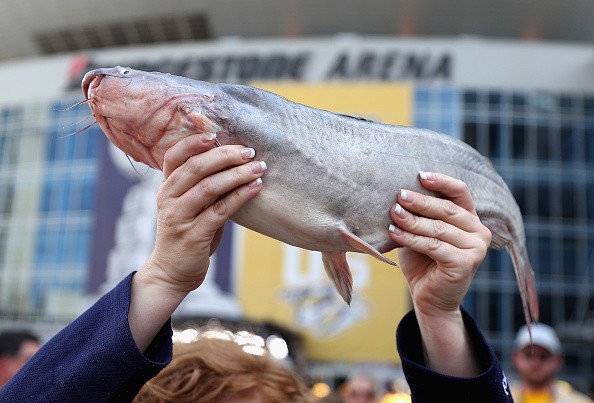A young angler recently caught a rare catfish that was almost entirely white just on the Tennessee River.
On June 28, Edwards Tarumianz, 15 years old, caught a strange fish while participating in a fishing trip led by Richard Simms of Scenic City Fishing Charters. The fish is a member of the species Ictalurus furcatus, also known as the blue catfish.
Albino blue catfish
 (Photo : Patrick Smith/Getty Images)
(Photo : Patrick Smith/Getty Images)

The predominant color of this species, which would be the largest catfish in North America, is bluish-gray.
Tarumianz's specimen, however, was primarily white with a few light pink spots on its fins, as per Newsweek.
Simms told Newsweek, they were stunned when they saw it. Regarding Edwards, he is not sure, and he's well aware of how incredibly uncommon it is.
The majority of fishermen fish all their lives never seeing one.
It was the first catfish ever saw in person. Simms is 67 years old, and over the years, he have literally boated thousands and thousands of catfish.
Simms claimed that the fishing was so extraordinary that if they hadn't captured a photo of the catfish, people might not have been able to believe it.
The captain speculated that the fish was a leucistic catfish. Various animals can develop leucism, which is categorized as a whole pale color or aspects with less coloring.
This condition results in white, pale, or patchy coloring in feathers, hair, skin, or scales, but it has no effect on the eyes. It is brought there by a genetic mutation that prevents the production of a melanin pigment as well as other pigments.
The possibility of the fish being an albino exists as well.
Another genetic disorder with a melanin-deficient appearance is albinism. In some cases, animals with albinism also have pink eyes in addition to white hair, feathers, skin, or scales.
The biologist of the Tennessee Wildlife Resources Agency (TWRA)however, told Field and Stream that they will be unable to identify the genetic disorder that Tarumianz's fish has. Pink nails, skin, scales, and eyes are characteristics of pure albino animals.
Anyhow, we can all agree that it was a fantastic and unusual catch, a TWRA representative told Field and Stream. Even though these sightings are uncommon in the animal kingdom, they do occasionally occur.
Read More: Rare Albino Flap Shell Turtle That Looks Like Melted Cheese Spotted in India!
Albinism
Albinism is a condition that affects numerous animals, including humans, and causes the skin and hair to lack pigment. Oculocutaneous albinism affects roughly 1 in 20,000 people around the world at birth. As per dailymail.
Although it's commonly believed that living things with albinism can be identified by one's red or pink eyes, this is not a characteristic of the condition.
Birds, mammals, reptiles, amphibians, and even fish have it. Although it's commonly believed that living things with albinism can be identified by one's red or pink eyes, this is not a characteristic of the condition. Birds, mammals, reptiles, amphibians, and even fish have it.
Leucism
Leucism causes a reduction in coloration, having left the animal pale or even with discolored patches. Although more common than albinism, leucism is also uncommon in animals. Birds, mammals, reptiles, amphibians, and even fish have it.
As a result of decreased coloration, the animal is primarily white with colored spots. When compared to albinism, leucism does not cause red eyes.
Related Article: LOOK: Rare Blue-Eyed Albino Orangutan Rescued From Captivity In Indonesia
© 2024 NatureWorldNews.com All rights reserved. Do not reproduce without permission.





